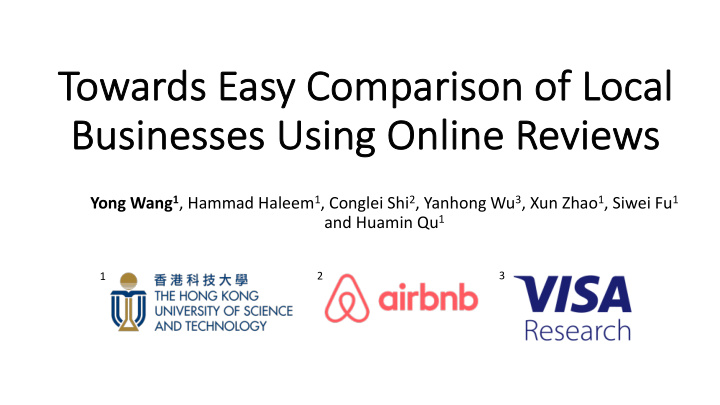



Towar ards Eas asy Co Compar aris ison of Lo Local al Busi Busine nesse sses s Usi sing ng Onl Online ne Reviews Yong Wang 1 , Hammad Haleem 1 , Conglei Shi 2 , Yanhong Wu 3 , Xun Zhao 1 , Siwei Fu 1 and Huamin Qu 1 2 3 1
Background 2
Review Platforms Yelp Airbnb TripAdvisor 3
Online Reviews vs Purchase Decisions Three-quarters of travelers have considered online reviews when planning their trips [1] 4 [1] Gretzel, U., & Yoo, K. H. (2008). Use and impact of online travel reviews. Information and communication technologies in tourism, 35-46.
Online Reviews 5
Challenges • There are usually many candidates satisfying users’ requirements • The online reviews are dynamically changing • The information overload due to the large volume of review texts, different review focuses, etc. • The possible standard inconsistency across different customers 6
How can we achieve easy comparison of local businesses using online reviews? 7
Our Approach: E-Comp 8
Design Requirements • General exploration procedures: Preliminary Detailed Comparison Comparison R1. Quick overview for filtering out candidates R2: reliable comparison between businesses R3: temporal analysis of user reviews R4: insightful details of important features R5: detailed review text on demand R6: intuitive visual designs 9
Our Approach: E-Comp Map View: Preliminary Comparison 10
Our Approach: E-Comp Detailed Comparison Common Customer View Augmented Word Cloud View Temporal View 11
Preliminary Comparison – Glyph Design 12
Preliminary Comparison – Glyph Design Overall Rating Review Number of Each Rating Total Review Number 13
Preliminary Comparison – Glyph Design Alternative Designs 14
Preliminary Comparison Interactive Filtering The link width encodes the number of common customers 15
Detailed Comparison • Common customer comparison view - The review standards by the same customers are relatively stable 16
Detailed Comparison • Common customer comparison view Interactive Exploration 17
Detailed Comparison • Common customer comparison view Alternative Designs 18
Detailed Comparison • Temporal view - Temporal trend of reviews 19
Detailed Comparison • Temporal view - Temporal trend of reviews 20
Detailed Comparison • Temporal view - Review helpfulness Helpfulness votes Review depth Review extremity 21 Mudambi, S.M. and Schuff, D. What makes a helpful review? A study of customer reviews on Amazon.com. MIS Quarterly 34, 1 (2010), 185–200.
Detailed Comparison • Temporal view - Review helpfulness Helpfulness votes Review depth Review extremity 22 Mudambi, S.M. and Schuff, D. What makes a helpful review? A study of customer reviews on Amazon.com. MIS Quarterly 34, 1 (2010), 185–200.
Detailed Comparison • Augmented word cloud view What kind of place? What is great? How is the service? Traditional Word Cloud Adjective+Noun Word Pairs http://firstmonday.org/article/view/5436/4111 23 Yatani, Koji, et al. "Review spotlight: a user interface for summarizing user-generated reviews using adjective-noun word pairs." CHI, 2011.
Detailed Comparison • Augmented word cloud view Service 24
Detailed Comparison • Augmented word cloud view - Extract adjective+noun word pairs 1. Use part-of-speech (POS) tagger in NLTK 2. A heuristic approach to keep the noun and the corresponding adjective that modifies it (Specifically process the case of negative expressions) 25
Detailed Comparison • Augmented word cloud view - Extract adj+noun word pairs - Classify word pairs into meaningful categories 1. Manually label a set of representative words for each category 2. Classify new words by computing the similarity between them and the labeled words using word2vec 26
Detailed Comparison • Augmented word cloud view - Extract adj+noun word pairs - Classify word pairs into meaningful categories - Group the word pairs and do the layout of clustered word pairs 1. Group the word pairs with the same noun into a cluster 2. Use standard NLTK library to detect the sentiment of each word pair 3. Layout: collision detection + Archimedean spiral 27
Detailed Comparison • Augmented word cloud view 28 food
Evaluation 29
In-depth User Interview • 12 participants with at least 3 years online shopping experience • Procedures: - Introduce our prototype system - Free exploration - Finish tasks of comparing local businesses - Feedback collection and questionnaire 30
In-depth User Interview • Feedback - Effectively supporting easy comparison : more insightful information is provided for both preliminary and detailed comparison - Good usability : visual designs are easy to learn - Limitations & suggestions : scalability, potential occlusion, NLP accuracy 31
Conclusion and Future Work • We present a carefully-designed visual analysis system to support easy comparison of local businesses using online reviews • Case study and in-depth user interview provide support for its effectiveness and usability • Further improve the language processing accuracy and study the images in the reviews 32
Towar ards Eas asy Co Compar aris ison of Lo Local al Busi Busine nesse sses s Usi sing ng Onl Online ne Reviews Yong Wang 1 , Hammad Haleem 1 , Conglei Shi 2 , Yanhong Wu 3 , Xun Zhao 1 , Siwei Fu 1 and Huamin Qu 1 2 3 1
Recommend
More recommend